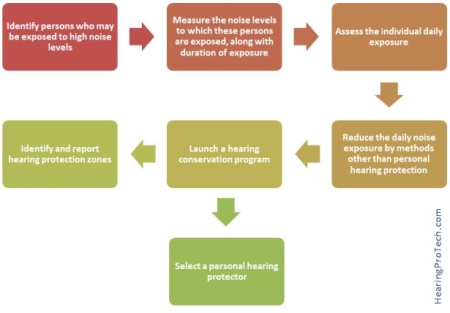A directive and two standards regulate personal hearing protectors (HPD) and their implementation.
1- Directive 2003/10/EC on 'Noise'
Transposed into French law by Decree 2006-892 of 19 July 2006 amending the Labor Code and the Order of 19 July 2006. Specifies the exposure limits for employees. It is these values that determine whether or not an employee requires hearing protection.
To summarize:
1) The threshold limit values for noise exposure for workers (TLV), taking into account the attenuation of HPD are:
- 87 dB (A) for a working day of 8 hours
- 140 dB(C) for peak pressure
If this is exceeded:
- Implementation of immediate measures to reduce the noise exposure
- Limiting the duration of the employee's exposure to noise
2) Higher exposure values requiring action are:
- 85 dB (A) for a working day of 8 hours
- 137 dB(C) for peak pressure
If this is exceeded:
- Implementation of a technical measurement program to reduce exposure to noise
- Signage of noisy workplaces and limiting access
- Using HPD
- Periodic audiometric tests
3) Lower exposure values requiring action are:
- 80 dB (A)
- 135 dB(C)
If these thresholds are exceeded:
- Provision of HPD
- Informing and training workers (noise hazards, measurement and means of prevention, use of HPD)
- Audiometric tests suggested
2- EN352 standard
A standard exists for each type of HPD:
- EN 352-1 for earmuffs
- EN 352-2 for earplugs
- EN 353-3 for earmuffs worn with hearing protection helmets
These standards establish the requirements for personal hearing protection in relation to the 89/686/EEC Directive. The special requirements concerning the capacity of personal hearing protectors to reduce noise levels below the daily limits are addressed in EN 352, which sets the sound insulation of hearing protectors (measured in accordance with EN 24869-1) to a specified minimum level. By additionally requiring a declaration of the measured sound insulation, the requirements help to select appropriate protectors according to established practice, based on individual requirements.
They also specify the requirements in terms of hardware, assembly, and ease of use, as well as comfort for the user. They analyze the minimum performance in regard to resistance to impact, low and high temperatures, and fire.
3- EN458 standard
The EN458 standard "Hearing protectors - Recommendations for selection, use, care and maintenance" was developed as a guide to any person who must supply, buy, or wear hearing protectors.
In order to make the most of the protection offered by hearing protectors, users should wear the hearing protectors as long as they are in a potentially dangerous noisy environment. Therefore, when it comes to selecting a personal hearing protector, it is important to consider some factors that can affect comfort and acceptance.
Using a flowchart, EN 458 defines the steps to be implemented in case of a localized noisy area that could be potentially dangerous for the employees who work there.
The first objective is to try to reduce noise at the source.
Details of measures to reduce individual risk
of hearing loss caused by noise (extracted from EN458)
Method of calculation and physical and acoustic testing
Three other standards complement the above two standards:
EN 4869-2 describes different methods of calculation (per octave band, HML, and SNR) to estimate the levels of effective A-weighted pressures when using HPD. The standards EN 13819-1 and EN 13819-2 respectively describe the physical and acoustic testing methods implemented during the certification of EN 352.





